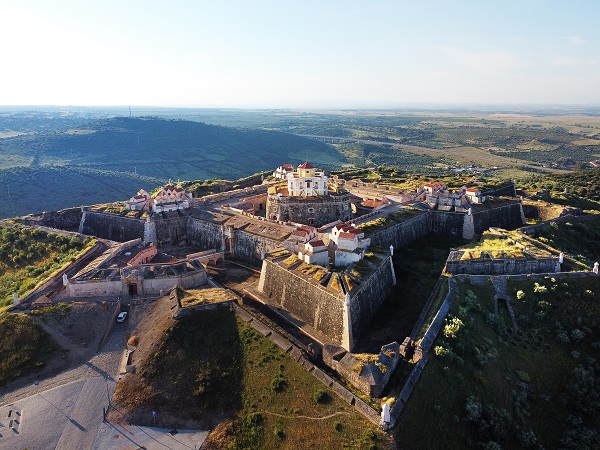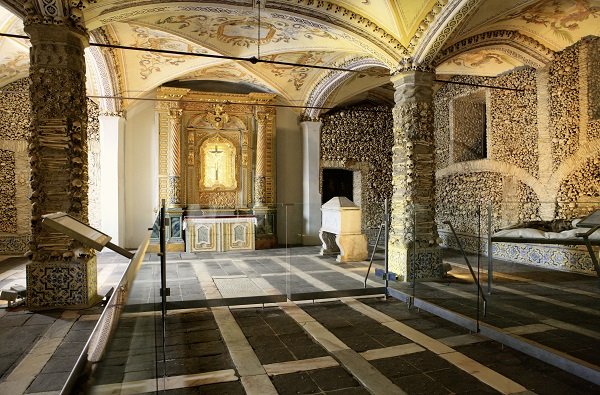Dark tourism is a thing, so much so that Netflix has a series on it. It is not for everyone, but it does sync with those seeking alternative destinations like the Paris Catacombs, Dracula’s Castle and the Tower of London, dealing with real life, loss, tragic history and the macabre. And, in Portugal, there is no lack of these off the beaten path sites, but the number one dark tourist site in Portugal has long been the Capela dos Ossos in Évora. This small chapel in the 16th century Church of St. Francis is on many travelers' bucket lists because the walls are covered and decorated with human skulls and countless bones. A ceiling and floor are the only parts of the chapel that are not covered in the human bones. It is estimated that there are over 5,000 skulls decorating the chapel, many of which were dug up from monastic cemeteries in the region.
To reinforce the dark message over the door is inscribed Nós ossos que aqui estamos pelos vossos esperamos - or - We, these bones here, await yours.
So, with such a tragic highlight, we ask, what other dark sites are there to consider in the Alentejo.
Mining is a dark and dangerous business and no one knows just how many people died working the mines of São Domingos. The flooded mine pit is a growing destination today. Copper ore was first mined here, but by the 1910s pyrite was mined to make sulfur, leading to the contamination of groundwater.
By 1966 the mines closed under pressure to clean up the mess. Today, the empty mine attracts tourists. Several of the former mine buildings and the open-cast pit remain. The former 1875 mining company headquarters has been converted into the Star Hotel. A museum and archive, the casa do mineiro, is an old miner's cottage and shows the hard life of a miner. There is also an exhibition in the town's old theater.
Elvas is famed for its massive fortifications that encircle the town. The well-preserved fortifications are testament to a long bloody history of this city smack on the Spanish border. Taken from the Arabs in 1230, Elvas became a vital fortress on the River Guadiana. That location meant constant attacks from Spain, including in 1580, 1644 ,1658, and 1801.During the Napoleonic Wars, Wellington launched a bloody assault on the French in Badajoz. With so much fighting Elvas is a dark reminder that walls make good neighbors.
Today, Elvas is still accessed through three massive gates with two outlying star-shaped forts. The original castle was built on Roman and Moorish ruins. The Military Museum is set in the former barracks.

The lost City of Ammaia was once a bustling hub in Roman times, and was lost when the empire fell and was only rediscovered in the last century. It has since been excavated and investigated by scientists from around the globe.
Built in the first century AD, Ammaia was a city with a forum, baths and temples. In the 1950s the first excavations were carried out and the vast size of the lost city was discovered. Ammaia was elevated to Civitas around the year 44/45 AD, having won the status of Mvnicipivm during the 1st century. But in the third century barbarians destroyed the city. By the time of the Moorish invasion the few remaining residents fled to the nearby hills around Marvão. The ruins are a silent testament that oceans do rise, and empires fall.
Estremoz Castle stands high over a hill, not far from Évora. It is a castle with a pentagonal plan, and a high marble keep. The nearby pousada is an elegant place to escape to, but there is a dark history here from the days of Portugal's 19th century Civil War.
The so-called "Warehouse Massacre" took place, in which more than 30 liberal prisoners were murdered at the hands of the population and part of the absolutist army. The Convention of Evoramonte was signed not far from here, on May 26, 1834.
Moura is a lovely town with a macabre coat of arms: a tower town with a dead woman at its feet. Here is the what it means. In 1166 a Moorish princess called Salúquia was set to wed a young man from a town to the North. On the eve of the marriage, the groom was ambushed by Christian knights, and killed. The Christians put on the robes of Muslims and made for Moura. With Salúquia in the castle tower waiting for her love to come, she saw the entourage return, and enter the gates. Then to her horror, they started to take the town — and the desperate princess threw herself to her death from the tower. Moved by the tragic love story, the conquering Christian called the town Terra da Moura Salúquia. The tower still stands, and the town still clings to the dark story of the dead princess, which its coat of arms attests to.
Our last suggestion is one that not long ago was a big driver of tourism, the bullfight. But, as world tastes changed, the Portuguese bullfight changed from a festival of bravery to one of perceived animal cruelty. The Alentejo remains the center of bull and horse breeding, and has dozens of active bullrings. The Tourada á Portuguesa is held right before sundown, so that the arena is a mix of shadow and light. The cavaleiro, or rider, is dressed in a silk jacket embroidered with gold and lace, with tan riding pants and black boots, and faces the black Iberian fighting bull with a goal not to kill the bull, but to place a dart in the bull¹s back muscle. Horse and bull must charge at each other, with the horse suddenly veering off to avoid an impact. Then the rider must place the colorful dart exactly and ride off.
Today jeep tours take tourists into the Montados to see the wild Iberian bulls in their natural habitat. While bullfighting has declined in popularity, it continues to fill arenas in Southern Portugal - a bloody and elegant spectacle that divides modern Portugal, but a rare tradition from ancient time that speaks of different sensibilities.



